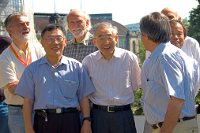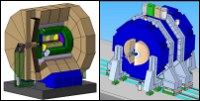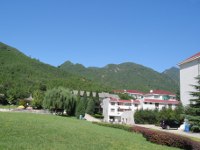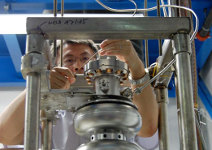 |
|
|
 |
Validation made of the Letters of Intent

At their recent meeting in Hamburg, the ILCSC approved the validation proposals for ILD and SiD.
Image: DESY |
ILC physics and detector community took a big step in August. The International Detector Advisory Group (IDAG) gave me a detailed report of their examination for the validation of the three Letters of Intents (LOIs) on 17 August. I wish to thank the chair and the members of IDAG for their extremely intensive work and devotion in their precise review of a large amount of material in a relatively short period after receiving the LOIs in March. The report describes examinations of all detector components and the evaluation of each detector as an integrated system with respect to the performance for benchmark reactions. They also inspected the machine detector interface under the push-pull requirement. The conclusion is that the International Large Detector concept (ILD) and the Silicon Detector Design Study concept (SiD) are recommended for validation as complementary detectors to go on with detailed design and that the dual-readout calorimeter technology is encouraged to be further developed. IDAG thanked all the groups for their intensive studies and work in preparing the LOIs and in answering their additional questions. I join this IDAG acknowledgment, knowing the tremendous efforts made by each group. IDAG chair Michel Davier will give a detailed presentation of the evaluation on the first day of the Linear Collider Workshop of the Americas (ALCPG) and Global Design Effort meeting, at Albuquerque, US.
Read more...
-- Sakue Yamada
Research Director's Report Archive |
 |
|
|
 |
Upcoming meetings, conferences, workshops
14th International Conference on RF Superconductivity (SRF2009)
Berlin, Germany
20-25 September 2009
2009 Linear Collider Workshop of the Americas (ALCPG09)
The University of New Mexico, Albuquerque, New Mexico, USA
29 September - 3 October 2009
The mysterious universe - Exploring our world with particle accelerators
Free public lecture by Jim Brau
University of New Mexico, Albuquerque (Anthropology Lecture Hall 163), New Mexico, USA
1 October 2009, 7pm
CLIC09 Workshop
CERN
12-16 October 2009
12th International Conference On Accelerator And Large Experimental Physics Control Systems (ICALEPCS 2009)
Kobe International Conference Center, Kobe, Japan
12-16 October 2009
Upcoming school
Fourth International Accelerator School for Linear Colliders
Beijing, China
7-18 September 2009
|
|
|
GDE Meetings calendar
View complete ILC calendar
|
|
|
 |
 |
|
|
 |
Progress on ILC detectors
International Detector Advisory Group completed its report

Two ILC detector concepts, ILD and SiD, have been validated by the International Detector Advisory Group. (SiD CAD model rendering courtesy of Marco Oriunno) |
ILD and SiD, two of the three detector concepts that submitted Letters of Intent, have been recommended for validation to Research Director Sakue Yamada by the International Detector Advisory Group (IDAG), chaired by Michel Davier. At their recent meeting in Hamburg, the ILC's Steering Committee endorsed the IDAG recommendations. This means that the R&D collaborations working on detector technologies and prototypes for the two ILC detector concepts ILD, the International Large Detector concept, and SiD, the Silicon Detector Design Study, will continue under full steam in their work towards the best design for detectors to understand collisions at the future ILC. The third detector concept that submitted an LOI, called '4th', was not validated. However, IDAG recommended that R&D on dual readout calorimetry done for 4th in a collaboration of many institutes should be supported in view of its potential for higher energy colliders.
Read more...
-- Barbara Warmbein |
 |
|
|
 |
From Jefferson Lab
17 September 2009
American-Made SRF Cavity Makes the Grade
The U.S. Department of Energy's (DOE's) Thomas Jefferson National Accelerator Facility marked a step forward in the field of advanced particle accelerator technology with the successful test of the first U.S.-built superconducting radiofrequency (SRF) niobium cavity to meet the exacting specifications of the proposed International Linear Collider (ILC)...
Read more... |
|
From Physics World
16 September 2009
CERN boss targets linear collider
The boss of CERN wants the next big experiment in particle physics after the Large Hadron Collider (LHC) to be built at the Geneva lab. Speaking in an interview with physicsworld.com, Rolf-Dieter Heuer said that CERN should host the experiment, which would collide electrons and positrons in a linear accelerator. Although a design for the machine has not been finalized by the international particle-physics community, Heuer is keen to bring the collider to CERN...
Read more... |
|
From Invernews
15 September 2009
ORGANIZADO POR EL IFCA Y EL CSIC: Expertos mundiales en Física debaten en Santander sobre la partícula de Higgs
Este congreso congregará en Santander a investigadores de renombre internacional en el campo de la búsqueda de la partícula de Higgs, tanto en el LHC (Large Hadron Collider) del Laboratorio Europeo de Física de Partículas CERN de Ginebra (inaugurado en 2008 y que comenzará a tomar datos en 2009), como en el Tevatron-Fermilab de Chicago y en el futuro colisionador de partículas ILC (International Linear Collider).
Read more... (in Spanish) |
|
From Times
11 September 2009
The future of physics: the iPod or the LHC?
...We need all to know that physics is not just dark matter and quarks but is also the means to solving our energy crisis; medical physics has saved hundreds of thousands of lives through the development of technologies like magnetic resonance imaging (MRI); and physics is a crucial key to successful commercial R&D, creating the next must-have gadget.
Read more... |
|
From Wired
9 September 2009
High-Energy Particle Physics Demystified
... They’re talking about a linear collider, which is the ILC, International Linear Collider. That’s in the early planning stages and that wouldn’t be a ring that would involve two linear accelerators colliding particles with each other which would require a lot of land. But the advantage of the linear colliders is that they can narrow down the energies and thus narrow down the masses more precisely.
Read more... |
|
From SLAC today
8 September 2009
Silicon Detector Validated, Moves Forward
Two of the three detector design concepts for the proposed next linear collider have been validated by the International Detector Advisory Group, and their conclusions endorsed by the International Linear Collider Steering Committee.
Read more... |
|
|
 |
Linear Collider Accelerator School underway in China

The beautiful venue for this year’s Linear Collider Accelerator School |
I write this week’s column as a lecturer at the fourth International Linear Collider accelerator science school that is underway at the Hotel Jixian in Huairou, located in a beautiful isolated park-like area about one hour from Beijing, China. This is a perfect place for an intensive school and seventy students are busy hearing a very good set of lectures, doing homework every night and making new friends. My lectures consisted of a full-day introduction to terascale physics, the ILC accelerator and detectors.
Read more...
-- Barry Barish
Director's Corner Archive |
 |
|
|
 |
From JLab: Practice makes perfect

Rongli Geng, a staff scientist in Jefferson Lab's Institute of Superconducting Radiofrequency Science and Technology, connects a cable to an International Linear Collider prototype accelerator cavity as he prepares it for testing. Geng is working to improve the performance of superconducting radiofrequency cavities for future accelerators. (JLab Photo).
Read the press release
|
|
arXiv preprints
0909.2398
Analysis of Tau-pair process in the ILD reference detector model
0909.1750
NLO QED Corrections to Hard-Bremsstrahlung Emission in Bhabha Scattering
0909.1317
The impact of a strongly first-order phase transition on the abundance of thermal relics
|
|

